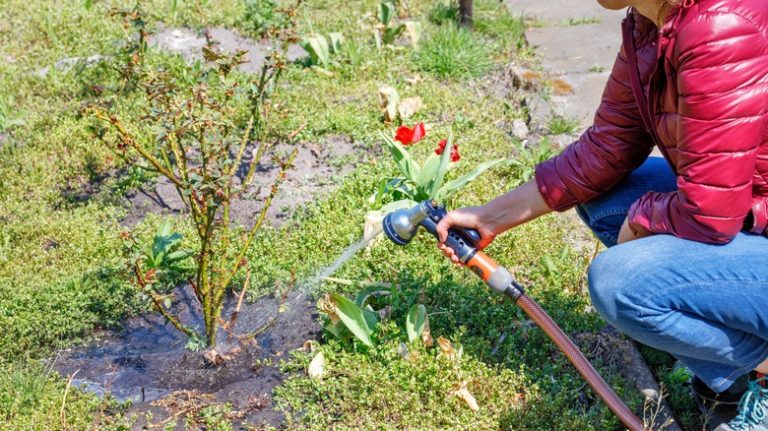There are several methods to propagate roses, including stem cuttings, layering, and grafting. The most common method is propagated by taking stem cuttings from the mother plant. This can be done in spring or fall, but the best time is in the early morning when the plant is hydrated and vigorous.
The first step is to select a healthy, disease-free stem that is about half the diameter of a pencil. Make a clean cut just below a leaf node and remove any flowers or buds. You can dip the cut end in rooting hormone to encourage root development.
Next, prepare a potting mix of equal parts peat moss and perlite or vermiculite. Moisten the mix and fill a plastic pot with drainage holes. Insert the cuttings into the potting mix, burying them about half their length. Firm the soil around the cuttings and water lightly.
Keep the potting mix moist but not soggy. Place the pot in a warm, sunny location, preferably with morning sun and afternoon shade. You can cover the pot with a plastic bag to create a mini greenhouse and increase humidity. Mist the cuttings regularly to help prevent them from drying out.
After a few weeks, the cuttings should start to form roots. You can gently tug on the cuttings to see if they are rooted. Once they are well-rooted, you can transplant them into individual pots or directly into the garden. Make sure to water them regularly and protect them from extreme weather conditions.
Another method of propagating roses is by layering. This is done by burying a flexible stem from a rose bush into the ground while it is still attached to the mother plant. After a few months, the buried stem will develop roots and can be cut away from the mother plant and planted as a separate shrub.
Overall, propagating roses can be a rewarding and satisfying experience. Whether you choose to propagate roses by stem cuttings, layering, or another method, it is important to pay attention to the specific needs of each rose variety and to provide proper care and maintenance to ensure successful propagation. With patience and care, you can create a beautiful garden filled with your favorite roses.
How to Propagate Roses
Roses are a beloved and beautiful flower, and many people want to learn how to propagate them to create more beautiful blooms. There are several methods to propagate roses, including using cuttings, layering, and even starting from seedlings. In this article, we will explore the various techniques to successfully propagate roses.
One of the most popular methods of propagating roses is through cuttings. This method is best done in the mild weather of early spring or late summer. To do this, start by selecting a healthy stem from the rosebush. Make a diagonal cut just below a leaf node, and remove any leaves from the lower half of the cutting. Dip the cut end into a rooting hormone, such as Hormex, to promote successful rooting. Then, plant the cutting into a mixture of soil and perlite, or any well-draining soil. Keep the soil moist by misting it regularly, and place the cutting in a location with filtered sunlight. Within a few weeks, roots should start to form, and you can then transplant the young rose plant to a larger pot or directly into the ground.
Layering is another propagation method that can be used to create more rose plants. This method is best done in the early spring or late summer, when the weather is mild and the rose plant is actively growing. To do this, select a healthy, flexible branch and find a spot on the stem that is low to the ground. Make a small vertical cut on the underside of the stem and then bend the stem down, burying the wounded part with soil. Use a small stake to hold the stem in place. Keep the soil moist, and within a few weeks, roots will start to develop from the buried part of the stem. Once the roots are well-established, you can cut the new plant away from the parent plant and transplant it to a new location.
Another method of propagating roses is through seedlings. This method is less common and less reliable, as the resulting plants may not produce the same blooms as the parent plant. However, if you enjoy experimenting and are patient, you can try propagating roses from seeds. Start by collecting rose hips from the parent plant once they turn red and begin to soften. Remove the seeds from the hips, and then sow them into pots filled with a mixture of potting soil and perlite. Place the pots in a sunny location and keep the soil moist. Germination can take several months or even up to a year, so be patient. Once the seedlings have grown large enough, you can transplant them to larger pots or directly into the ground.
Propagating roses can be a rewarding and enjoyable process for any rose lover or gardener. Whether you choose to propagate through cuttings, layering, or seedlings, proper care and attention are key to success. By using the right techniques and providing the ideal conditions for growth, you can fill your garden with beautiful rose plants and enjoy their stunning blooms for years to come.
Cuttings
In the world of propagating roses, cuttings are one of the most popular methods used by both novice and experienced gardeners. This method is preferred by many because it is a relatively easy and lazy way to propagate roses. So, let’s see how you can use cuttings to propagate your roses!
The process starts with selecting a healthy rose plant, preferably one that has strong and disease-resistant characteristics. Cuttings can be taken from a variety of roses, including hybrid teas, climbers, and even antique roses like Gallica. Just make sure to choose a variety that you really like and want to propagate.
When taking cuttings, it’s important to do so during the right time of year, which is usually between July and August in most regions. Cuttings should be about 6-8 inches long and taken from the current year’s growth. The ideal cutting consists of a straight stem with 3-4 leaf sets and a bud. It’s also recommended to collect cuttings from healthy, disease-free plants.
Once you have selected and collected your cuttings, you can proceed with the propagation process. Start by removing any thorns or leaves from the lower half of the cutting. Then, dip the cut end into a rooting hormone powder to improve root development. After that, you can plant the cuttings into a blend of potting soil and perlite or vermiculite, making sure to bury them about halfway down their length.
To ensure success, it’s important to keep the cuttings in a warm and bright area, but away from direct sunlight. Placing a plastic bag over the pot can create a mini greenhouse effect and help to retain moisture. Water the cuttings regularly, making sure the soil is well-drained and not overly wet. Mist the plants with water occasionally to increase humidity and prevent drying out.
Over time, the cuttings will start to develop roots and new growth. This process usually takes a few weeks to a couple of months, depending on the variety and conditions. Once the cuttings have rooted and established themselves, you can carefully transplant them into individual pots or directly into your garden.
It’s worth noting that some roses, particularly those that are grafted onto a rootstock, may not root easily from cuttings. In such cases, other methods like layering or sucker propagation may be more suitable. In general, however, propagating roses from cuttings is a commonly practiced method among rose growers and can be a rewarding way to increase your collection of beautiful roses.
So, if you’re a rose lover and want to expand your garden or simply try your hand at propagating roses, why not give cuttings a try? With a little patience and care, you can easily grow more roses to enjoy and share with others.
Layering
Layering is another method of propagating roses. It is a fairly easy and reliable technique that can be done by anyone, even those without much experience in gardening. This method involves taking a stem from the mother plant and burying it in the soil so that it can develop roots while still attached to the parent plant.
To start the layering process, choose a stem from the rose bush that is about one year old and has partially grown. The stem should be healthy and free from any diseases. It is best to do this in the early spring, around March, when the weather is mild and the plant is starting to grow.
Begin by selecting a spot near the base of the rose bush where you want to create a new plant. Make a small cut on the underside of the stem and dust it with a rooting powder. Then, gently bend the stem downwards and bury it in the soil, leaving about a foot of stem above the ground. Make sure the stem is in contact with the soil by pressing it down firmly.
It is important to keep the soil around the buried stem moist, but not too wet. Water the stem regularly, especially during dry spells or hot weather. In California, where the weather can be quite dry and hot, it is important to water the layering site in the early morning or late afternoon to avoid heat stress. Mist the stem with water occasionally to provide extra moisture.
After about a week or so, you should start to see new roots forming on the stem. Once the roots are well developed, you can cut the stem from the parent plant and transplant the new rose bush to a new location or a container. Transplanting should be done in the late summer or early fall when the weather is cooler.
Layering is a great way to propagate roses because it allows you to create new plants that are genetically identical to the parent plant. This method is particularly useful for propagating roses that do not root easily from cuttings or for growing roses that have desirable characteristics. It is also a good method to use if you are a bit lazy or don’t want to put in too much effort into grafting or other more complex forms of propagation.
If done correctly, layering can be a very successful method of propagating roses. With the right care and attention, you can easily grow new roses from existing plants and expand your rose garden.

